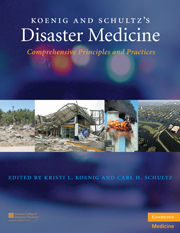Book contents
- Frontmatter
- Contents
- List of Contributors
- Contributor Biographies
- Foreword
- Preface
- Acknowledgments
- PART I CONCEPTUAL FRAMEWORK AND STRATEGIC OVERVIEW
- PART II OPERATIONAL ISSUES
- PART III CLINICAL MANAGEMENT
- SECTION A CBRNE AND HAZMAT
- 26 Explosive Events
- 27 Burn Patient Management
- 28 Clinical Aspects of Large-Scale Chemical Events
- 29 Biological Events
- 30 Nuclear and Radiological Events
- 31 Hazardous Material, Toxic, and Industrial Events
- SECTION B ENVIRONMENTAL EVENTS
- Index
- Plate section
- References
27 - Burn Patient Management
from SECTION A - CBRNE AND HAZMAT
Published online by Cambridge University Press: 05 August 2011
- Frontmatter
- Contents
- List of Contributors
- Contributor Biographies
- Foreword
- Preface
- Acknowledgments
- PART I CONCEPTUAL FRAMEWORK AND STRATEGIC OVERVIEW
- PART II OPERATIONAL ISSUES
- PART III CLINICAL MANAGEMENT
- SECTION A CBRNE AND HAZMAT
- 26 Explosive Events
- 27 Burn Patient Management
- 28 Clinical Aspects of Large-Scale Chemical Events
- 29 Biological Events
- 30 Nuclear and Radiological Events
- 31 Hazardous Material, Toxic, and Industrial Events
- SECTION B ENVIRONMENTAL EVENTS
- Index
- Plate section
- References
Summary
OVERVIEW
Geopolitical events in the last several years have sparked the interests of governments and medical organizations in disasters, terrorism, disaster planning, and evaluation and treatment of patients resulting from disaster or terrorist acts. Arson has not typically been included in the terrorist's agenda. Terrorists usually aim their attacks at human beings directly, whereas fires usually destroy property primarily and injure people only in passing. Hence, injuries from burn disasters are not typically different from injuries from burn nondisasters, except that the number of burn patients is larger in the former than in the latter. Some of the newer explosive devices used in terrorist attacks have led to casualties with severe combined penetrating, blunt, and burn trauma.
This chapter builds on principles of disaster management to highlight the key features of a regional burn disaster plan. Typical injuries that are best treated in the burn center facility will be highlighted. Burn rehabilitation, although an integral part of burn care, is beyond the scope of this chapter.
STATE OF THE ART DISASTER PLANNING
A review of burn disasters in the United States over the past 100 years shows that these events are local disasters, and the most common scenario is a large group of people caught in some type of structure that catches fire and is either land based or sea based. The number of burn victims has steadily decreased over the years so that typical numbers of burn victims requiring hospitalization in the late 1990s seldom exceeded 20–50 patients.
Keywords
- Type
- Chapter
- Information
- Koenig and Schultz's Disaster MedicineComprehensive Principles and Practices, pp. 423 - 429Publisher: Cambridge University PressPrint publication year: 2009



